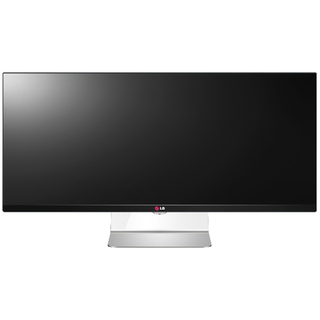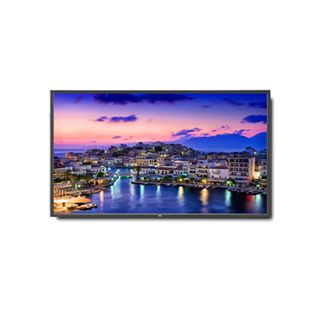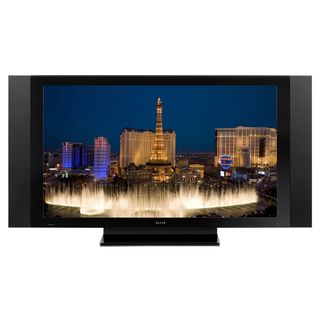Samsung PN51F8500 Review: A 51-Inch Plasma HDTV With SmartHub
Only two companies still make plasma TVs, so we’re excited to check out Samsung’s latest, the PN51F8500. It boasts 3D, SmartHub 2.0, and superb image quality. In the vast ocean of LCD televisions, it’s a compelling choice. Our lab results show you why.
Results: Brightness and Contrast
For more information on our test methodology, or simply what our benchmarks measure, check out our display testing reference page: How We Test Monitors and TVs.
Our comparison group represents all of the HDTVs we’ve tested to date, plus LG’s 34UM95, a general-purpose sRGB computer monitor.
Uncalibrated
The light output requirements of an HDTV are somewhat different than those for computer monitors. However, we still want to see how bright the display goes, which may mean using a less-than-accurate picture mode that affects color and visible detail.
Most plasma panels modulate their light output with the contrast control. Samsung, however, adds a unique adjustment called Cell Light, which has 20 brightness levels. It acts like the backlight slider from an LCD display.
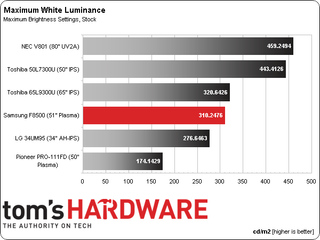
When people ask me, “LCD or plasma?” my first response is, “How much brightness do you need?” LCD technology is much brighter (sometimes twice as much) than the average plasma panel. Samsung bucks that trend with its F8500. In Dynamic mode, I get a maximum number that beats many of the LCD panels I’ve measured. You could easily use the F8500 in a sun-lit room and still enjoy excellent picture quality.

Plasma is best-known for its low black levels. After Pioneer set the bar in 2008 with its Kuro Elite models, other manufacturers have been working to beat that mark. The F8500 comes really close. While a difference of .0057 cd/m2 seems tiny, you can see it in a side-by-side comparison. There’s no question that plasma is well ahead of LCD in the black level contest.
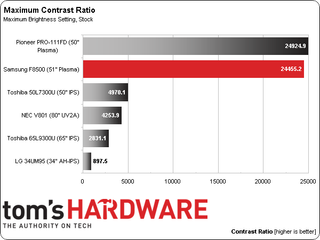
Thanks to its prodigious output, the F8500 nearly matches our reference Pioneer Kuro in overall maximum contrast, too. Remember that we’re measuring Dynamic mode, so you have to accept some compromises in color accuracy to realize such lofty figures.
Stay on the Cutting Edge
Join the experts who read Tom's Hardware for the inside track on enthusiast PC tech news — and have for over 25 years. We'll send breaking news and in-depth reviews of CPUs, GPUs, AI, maker hardware and more straight to your inbox.
Calibrated Day & Night Modes
For the Day mode, we target a value of 170 cd/m2, which is enough light for just about any media room or dedicated home theater. If you prefer the American luminance unit, that's a bit less than 50 foot-Lamberts. Some might consider this too bright for critical viewing, but remember, we're looking at a peak number. Most content doesn't display the brightest output except in highlights or the occasional sun-lit scene. Ultimately, it’s up to you. However, we want a consistent value for comparing future displays.
We chose a maximum output of 120 cd/m2 (or 35 fL) for Night mode. This is the value used in pro graphics systems, which assumes a darkened, light-controlled space. It’s also good for watching TV in total darkness or with just a little ambient light.
Our comparison charts show the Day mode.

The Cell Light control is fairly coarse in its adjustment, so we couldn’t hit 170 cd/m2 on the nose. Each click represents about 12 cd/m2. We also lowered the Contrast a little to dial in the excellent grayscale results you’ll see on page eight.

The calibrated black level is almost exactly the same as our uncalibrated measurement, meaning that on/off contrast numbers change solely based on the position of the Contrast and Cell Light controls. Bottom line: you’ll see the F8500’s best black levels regardless of your maximum output preference.
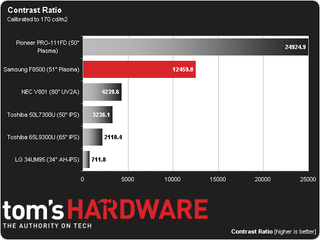
While Samsung's F8500 doesn’t match our reference Pioneer Kuro, it still lays waste to every LCD panel we’ve measured. Contrast like this makes for a truly 3D-like image with tremendous depth and clarity.
In Night mode, we measured a white level of 116.226 cd/m2, a black level of .0128 cd/m2, and a contrast ratio of 9081.5 to 1. Again, as you lower the Cell Light control, black levels stay about the same; only the white level changes. As a result, contrast goes down as you reduce output. LCD panels have more consistent contrast ratios, but even at its dimmest, the F8500 measures better than any LCD we’ve tested.
ANSI Contrast Ratio
Another important measure of contrast is ANSI. To perform this test, a checkerboard pattern of sixteen zero and 100-percent squares is measured. We get a somewhat more real-world metric than on/off measurements because we're testing the display’s ability to simultaneously maintain both low black and full white levels, plus factoring in screen uniformity. The average of the eight full-white measurements is divided by the average of the eight full-black measurements to arrive at the ANSI result.
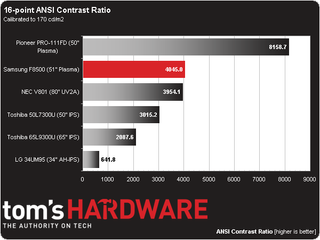
The ANSI result drops to about one-third of the on/off number for both plasmas in our comparison. Where an LCD’s numbers are a function of the grid polarizer quality, plasma panels rely on a robust power supply to maintain high white levels in the checkerboard pattern. Samsung doesn't appear to cut corners on that all-important component.
The F8500 includes a three-level Dynamic Contrast control, which is locked to the highest setting in Dynamic mode and fully adjustable in the other modes. Its effect is best illustrated in our gamma charts on the next page. Contrast is altered mainly by increasing light output. Black levels are unchanged, but we did observe crushed shadow and highlight detail, even at the Low setting. Frankly, the panel’s native contrast is so good we just don’t see a reason to use it.
Current page: Results: Brightness and Contrast
Prev Page Measurement And Calibration Methodology: How We Test Next Page Results: Grayscale Tracking and Gamma Response
Christian Eberle is a Contributing Editor for Tom's Hardware US. He's a veteran reviewer of A/V equipment, specializing in monitors. Christian began his obsession with tech when he built his first PC in 1991, a 286 running DOS 3.0 at a blazing 12MHz. In 2006, he undertook training from the Imaging Science Foundation in video calibration and testing and thus started a passion for precise imaging that persists to this day. He is also a professional musician with a degree from the New England Conservatory as a classical bassoonist which he used to good effect as a performer with the West Point Army Band from 1987 to 2013. He enjoys watching movies and listening to high-end audio in his custom-built home theater and can be seen riding trails near his home on a race-ready ICE VTX recumbent trike. Christian enjoys the endless summer in Florida where he lives with his wife and Chihuahua and plays with orchestras around the state.
-
Nuckles_56 People still buy plasma screened TV's? I thought they went out like the floppy disk...Reply -
Merry_Blind Damn Samsung TVs have so much lag... They have amazing picture quality, but aren't fast enough for proper gaming... sigh... bring on the OLED!!!Reply -
n3cw4rr10r Am I the only one who thinks this is overpriced? especially with 4k TVs getting close to this range (Vizio P series will be out soon for $1000).Reply -
n3cw4rr10r Am I the only one who thinks this is overpriced? especially with 4k TVs getting close to this range (Vizio P series will be out soon for $1000).Reply -
colson79 It is such a shame everyone bailed on Plasma TV's, I still have one and the picture quality blows away LCD in the home theater. Hopefully my Plasma will last until OLED is reasonable. It would suck having to go to LCD.Reply -
jkhoward I love the quality of Plasma TV's.. I truly hope they keep developing this technology.Reply -
DisplayJunkie @Nuckles_56 your level of ignorance is astronomical yet not uncommon; you are making a fool of yourself.Reply
@n3cw4rr10r It's not overpriced at all, but rather an outstanding value (though not as good a value as the sorely-missed Panasonic P50ST60). The image quality is tremendously better than any 4K TV, even with perfect 4K source content, even if they sold the 4K TVs for $1500 or less. The difference in contrast(dynamic range) is the most important, and it is huge. Side-by-side with the plasma, no one would pick any 4K LCD. -
nthreem It's worth noting that Samsung announced it will discontinue production of plasmas at the end of the year. Better pick one up soon!Reply
I got a Panasonic VT60 at the beginning of the year, just as stock was running dry. I'm still amazed by the picture quality. -
Nintendo Maniac 64 ReplyHopefully my Plasma will last until OLED is reasonable.
Actually OLED is arguably already there or getting there. Some people were able to pick up LG's 55" OLED TV for $2000 (not a typo) via in-store at Microcenter.
For a more universal price-point, it's newest revision is now going for $3500. -
photonboy ReplyDamn Samsung TVs have so much lag... They have amazing picture quality, but aren't fast enough for proper gaming... sigh... bring on the OLED!!!
Most HDTV's have a "GAMING MODE" option which disables video processing inside the HDTV for a particular HDMI input such as your game console might use.
Having said that, burn-in issues have never been completely solved so I wouldn't game on a Plasma anyway (seems an important thing to mention doesn't it?).
Most Popular


